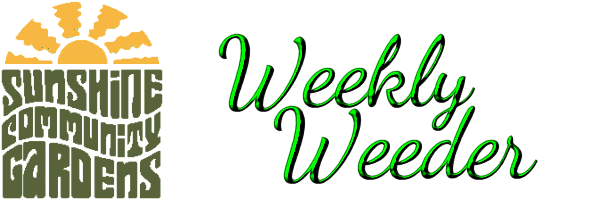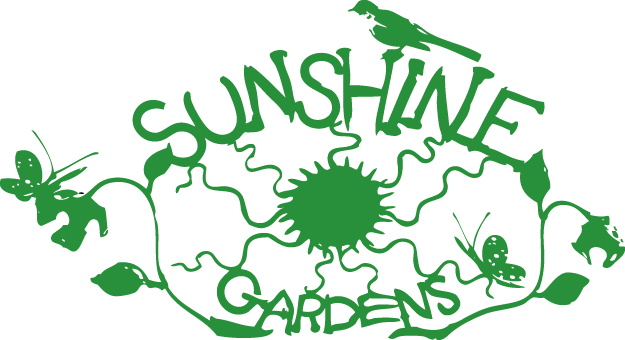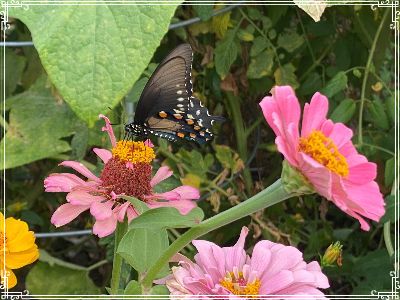
8 July, 2021
www.sunshinecommunitygardens.org
If you are signed up to receive the Weekly Weeder and have not been receiving it, here is a troubleshooting page to help. If this doesn't help, please let Sharon at scgardenweb@gmail.com know. Thanks.
In this Issue:
- Preparing for your Fall Garden - Herbs
- Butterfly Photo
- Needed Service Hour Tasks and Update on 2021 Hours
Preparing For Your Fall Garden
Fall is for Herbs
from Texas A&M AgriLife Extension Fall Planting Guide
Herbs are plants that are used as flavoring in foods. The common herbs used in cooking are referred to as culinary herbs. Mild or savory herbs impart a delicate flavor to food, while the stronger or pungent herbs add zest. Herbs are also planted for their ornamental value.
Planting and propagation
Select a sunny, well-drained location. At planting, apply a slow-release fertilizer at the rate of 2 pounds per 100 square feet. Herbs can be annuals (live only one season) or perennials (grow back from their root systems each year).
Annual herbs can be planted in an annual flower garden or vegetable garden. Plant perennial herbs at the side of the garden where they won't interfere with next year's soil preparation. Some herbs can be established by planting the seed directly in the garden or by starting seed indoors for later transplanting to the garden. You can obtain seed from a local garden center or seed catalog, or save the seeds produced by the herb plants for next year's crop.
To save your own seeds, harvest the entire seed head after it has dried on the plant. Then allow the seeds to dry in a protected location that is cool and dry. After the seeds are thoroughly dry, separate them from the seed heads and discard the trash.
Store the seeds in sealed, labeled jars in a dark, cool, dry location. Some herb seeds such as dill, anise, caraway, or coriander can be used for flavorings.
Perennial herbs can be propagated by cuttings or by division. Herbs such as sage and thyme can be propagated by cuttings. Chives can be propagated by dividing the roots or crowns.
Divide the plants every 3 to 4 years in the early spring. Dig them up and cut them into several sections. Or, cut 4- to 6-inch sections of the stem and place the cuttings in moist sand in a shady area. In 4 to 8 weeks, roots should form on these cuttings.
Care for the herb garden is the same as for a vegetable or flower garden.
Watering
Water as necessary during dry periods. Generally, herbs need about 1 inch of water per week, either from rainfall or from irrigation. Mulch will help conserve soil moisture as well as reduce weed growth. Because mints prefer moist soil, they must be watered more often.
Harvesting
The leaves of many herbs, such as parsley and chives, can be harvested for fresh seasonings. Gradually remove a few leaves from the plants as you need them. Don't remove all the foliage at one time. With proper care, these plants will produce over a long period.
To harvest rosemary and thyme, clip the tops when the plants are in full bloom. The leaves and flowers are usually harvested together. Basil, mint, sage, and sweet marjoram are harvested just before the plant starts to bloom. Parsley leaves can be cut and dried anytime.
Drying
After harvest, hang the herbs in loosely tied bundles in a well-ventilated room. You can also spread the branches on a screen, cheesecloth, or hardware cloth. Spread the leaves on flat trays. Cover the herbs with a cloth that will keep dust off but allow moisture to pass through.
Many of the herbs we grow today are from the Mediterranean region, so hot, dry summer weather suits them perfectly. Herbs need good drainage (they do best in a raised bed) and the right exposure. Most require full sun. Mints and a few other herbs grow well in shade or partial shade.
Dill is used in pickling. It can also be added to fish, cottage, cheese, cream cheese, salad dressings, and most vegetables. The dried seed can be added to bread dough for a caraway-like flavor.
Parsley is probably the most used and least eaten herb in the world because it is used mostly as a garnish. Parsley is a biennial, producing leaves the first year and flowers the next. There are two forms: the flat-leaved or Italian parsley, and the curly or French parsley. Many hybrids of each are available as seeds or transplants. The seeds germinate slowly, but parsley is worth the wait. It is loaded with vitamins and minerals. It can be battered and deep-fried, or browned with butter and garlic to make a basting sauce for grilled meats.
Sage doubles as a durable landscape plant. It is very drought resistant and can be killed by overwatering. Although sage is best started from transplants or cuttings, it can be started from seed. Varieties of sage include blue, clary, garden, golden, pineapple, and tri-color. All can be used in cooking. Sage leaves should always be dried before use. It can be used in black-eyed peas, chicken, egg and cheese dishes, pork, and poultry stuffing. When dried, leaves will keep their flavor for years.
Thyme is a good ornamental in beds and rock gardens. There are more than 400 species of thyme, including common, English, golden, lemon, mother of-thyme, silver, and woolly. Thyme is used in soups and fish, meat, poultry, and vegetable dishes. Add a pinch of thyme to a tablespoon of honey and mix with drained cooked carrots and onions. Thyme is a key herb in making Cajun gumbo. Along with sage, rosemary, marjoram, and oregano, thyme should be considered a basic of every herb garden.
Next Week's Weeder: Types of Herbs that do well in Texas
Needed Service Hour Tasks - July 8, 2021
To help keep gardeners aware of wha service hour tasks are needed, an attempt will be made to keep this list current.
Priority (Tasks specifically needed)
- Weeding and putting down wood chips on north side of the garden on right as drive into Sunshine (under desert willow).
- Cleaning curb gutter on 49th St. (TSBVI) (Remove bermudagrass which has grown up in gutter - particularly on east end.)
- Weeding inside south greenhouse
- Removing hackberries fence line along 49th St. and Sunshine Dr. (TSBVI) (Try to remove as deep below ground as possible.) Weeding inside greenhouses.
- Digging up khaki weed. (TSBVI) (Board has authorized to count as TSBVI hours)
- Maintaining common paths.
TSBVI
- Removing hackberries and Johnson grass growing in cyclone fence around Sunshine. (Please try to dig out as much of the roots as possible. Hackberries should be cut off as deep below ground level as possible.)
- Cleaning street curb gutters of dirt and debris build up. (At places in the curb gutter along Sunshine Dr. and 49th St., soil and debris has built has up and grass beginning to grow. Scrape off with shovel and put in wheelbarrow. If debris is gravel can be put in low places in parking lot. Otherwise, put in dumpster.)
- Weeding granite paths in raised bed area and edging border. (Try to get out roots - particularly the bermudagrass along west side by garden plots.)
- Weeding paths in TSBVI garden and wood chip areas on west side. (This is normally needed. Try to get out roots. Be sure to smooth out paths after weeding to facilitate TSBVI students moving around garden.)
- Mowing between fence and street along 49th St. and Sunshine Dr. along and 10' inside fence. (Frequent mowing will be needed this time of year.)
- Picking up trash in compost area and along fence lines.
Regular
- Mowing (Please check area around trailer and greenhouses. Frequent mowing will be needed this time of year.)
- Maintaining common paths. (Gardeners are required to maintain a 2' strip of common paths adjacent to their plot.)
- Mowing and cleaning up overgrown/messy areas in common areas.
Note: TSBVI hour tasks can also count as regular hours.
Update on Service Hours for 2021
The SCG Board decided to combine the 2021 spring and fall service hours, as it did in 2020. Many gardeners are accustomed to volunteering in the spring for the Plant Sale, and this was not an option this year. This will likely be the last time that spring and fall service hours will be combined for the year.
Gardeners will not be billed for any unworked spring service hours, but those hours will be carried over and added to the gardener's fall hours. For example, a full plot gardener with 2 unworked regular spring hours will need to work 10 regular hours (8 normal fall hours + 2 carried over) plus 1 TSBVI hour by end of the Fall season. Gardeners with any unworked hours for the combined spring and fall seasons will be billed for those unworked hours at the end of the fall season.
Many thanks to all the gardeners who have already worked their spring 2021 service hours, and be sure to record them in the Virtual Green Binder on Sunshine's website. The Virtual Green Binder for Fall 2021 hours is also available on the website now. Gardeners with unworked spring service hours or those who want to get started on fall service hours please see the list of tasks above.
Weeder Content
Please submit
weekly weeder articles, photos, and recipes by Wednesday to both Co-Editors:
Holly Gilman at hollyjgilman@gmail.com and
Maria Beach at dr.maria.beach@gmail.com
Officer and Zone Coordinator Contacts - Sunshine Gardens
Officers
- President - James "Jim" Willmann jhwillmann@gmail.com
- Vice-President - Steve Camp campinthegarden@yahoo.com
- Secretary - Kerry Drake kerryadrake@gmail.com
- Treasurer - Debra Marino scgtreasurer1@gmail.com
- Director - Kay McMurry scg.plots@gmail.com
- Director - Marsha Riti marshariti@gmail.com
- Director - Doug Zullo dugzoo@gmail.com
Email the board.
Zone Coordinators
- Zone 1, Susan Wallar swallar@gmail.com
- Zone 2, Wayne Kuenstler wckuenstler@gmail.com
- Zone 3, Ludmila Voskov lvoskov@austin.rr.com
- Zone 4, Ila Falvey ila.falvey@gmail.com
- Zone 5, Mary Gifford mgifford@austin.rr.com
- Zone 6, Charlotte Jernigan charlotte@cybermesa.com
- Zone 7, Jeff Schulz chilihead.schulz@gmail.com
- Zone 8, Steve Uecker steven_uecker@hotmail.com
- Zone 9, Kerry Howell casonhowell@gmail.com
- Zone 10, Christopher Schroder
christopher.s.schroder@gmail.com &
Karl Arcuri karl.w.arcuri@gmail.com
Other Personnel
- Weekly Weeder Newsletter - Holly Gilman hollyjgilman@gmail.com
- Plant Sale - Randy Thompson & Janet Adams jartdaht@gmailcom
- TSBVI Liaison & Volunteer Coordinator - Janet Adams jartdaht@gmailcom
- Plot Assignment - Kay McMurry scg.plots@gmail.com
- Compost Coordinator - Janet Adams jartdaht@gmail.com
- Carpentry & Repairs - Robert Jarry r.jarry@sbcglobal.net
- Water Leak Repairs - Steve Schulz sschulz784@aol.com
- Tools & Wheelbarrows - Bob Easter bob@easterandeaster.com
- Gas Mowers - Ray Porter Gasmowers@icloud.com
- Cordless Mowers/Trimmers - Steve Camp stcole431@yahoo.com
- Kitchen Supplies - Anita Keese
anodekraft1@msn.com
(If supplies are needed for events, contact by email or at 512-773-2178) - Compost Tea -
- Micah 6 - Dana Kuykendall kuykendall@austin.rr.com
- Micah 6 - Mary Gifford mgifford@austin.rr.com
- Website Coordinator - Sharon Rempert scgardenweb@gmail.com
Record Service Hours Online - Green Binder
Garden Thoughts
Calendar
Ongoing
Board Meetings
Second Tuesday of every month.
Copyright © 2025 Sunshine Community Gardens
Location: 4814 Sunshine Dr. Map
Mailing Address: Sunshine Community Gardens, P.O. Box 302349, Austin, TX 78703-0040





